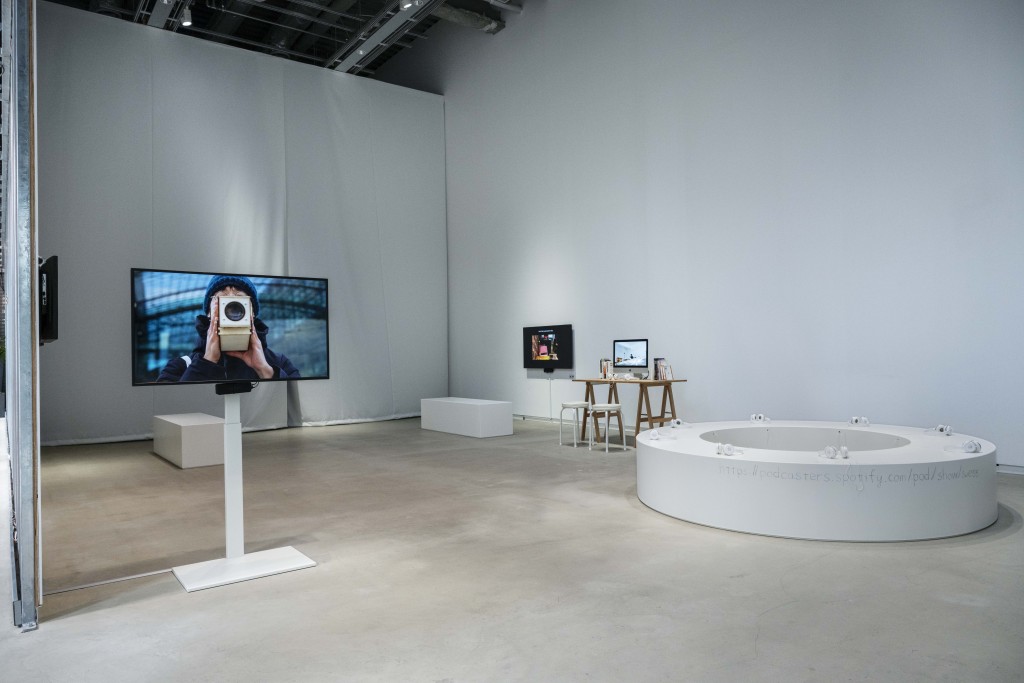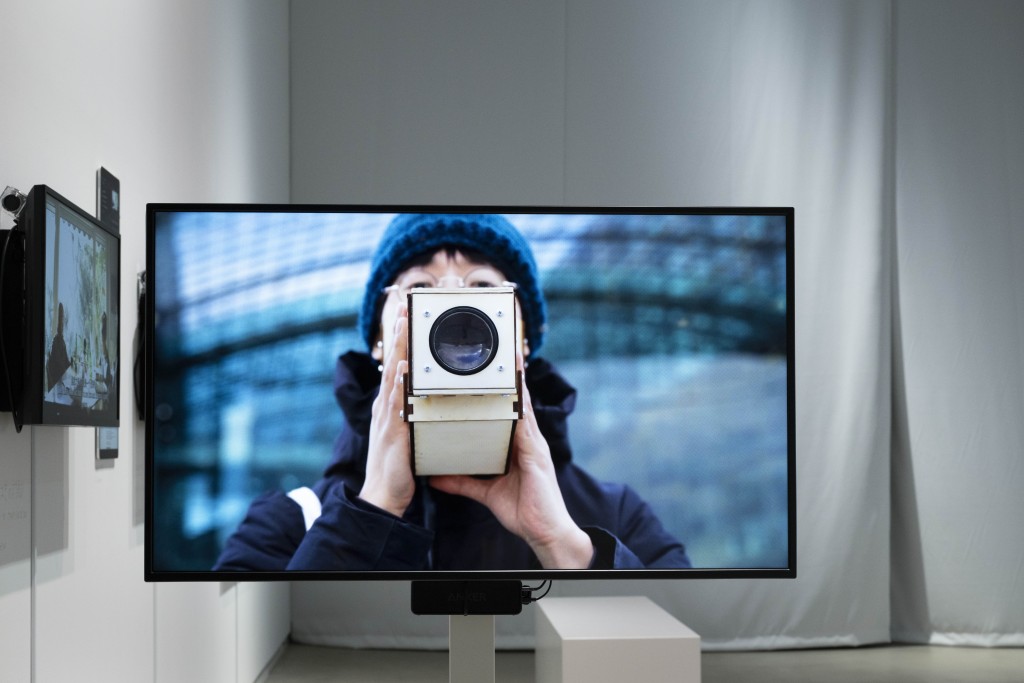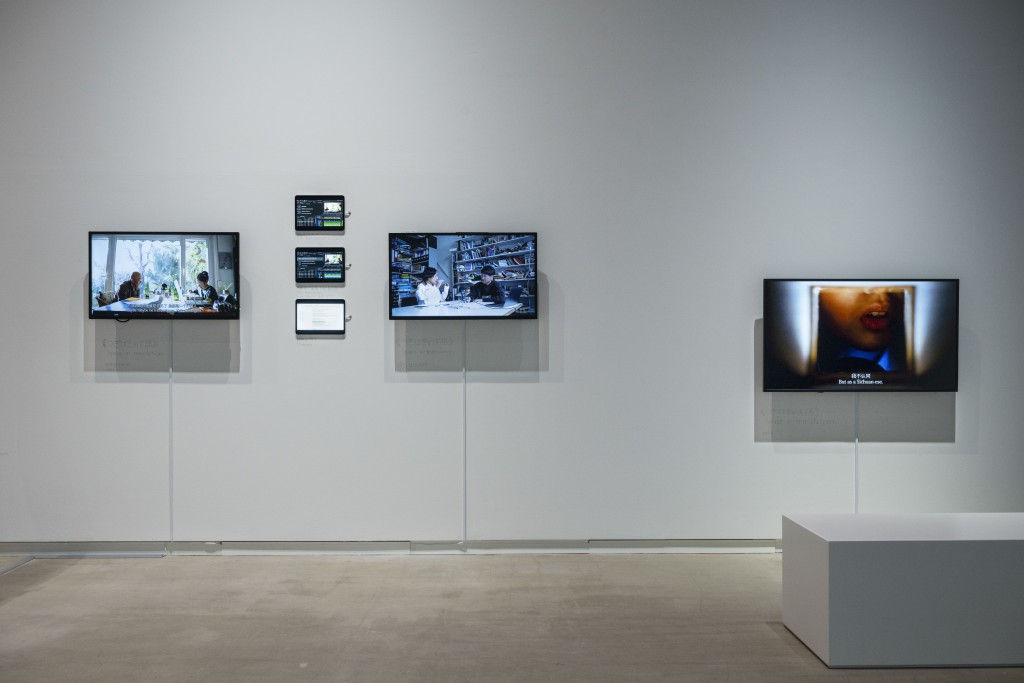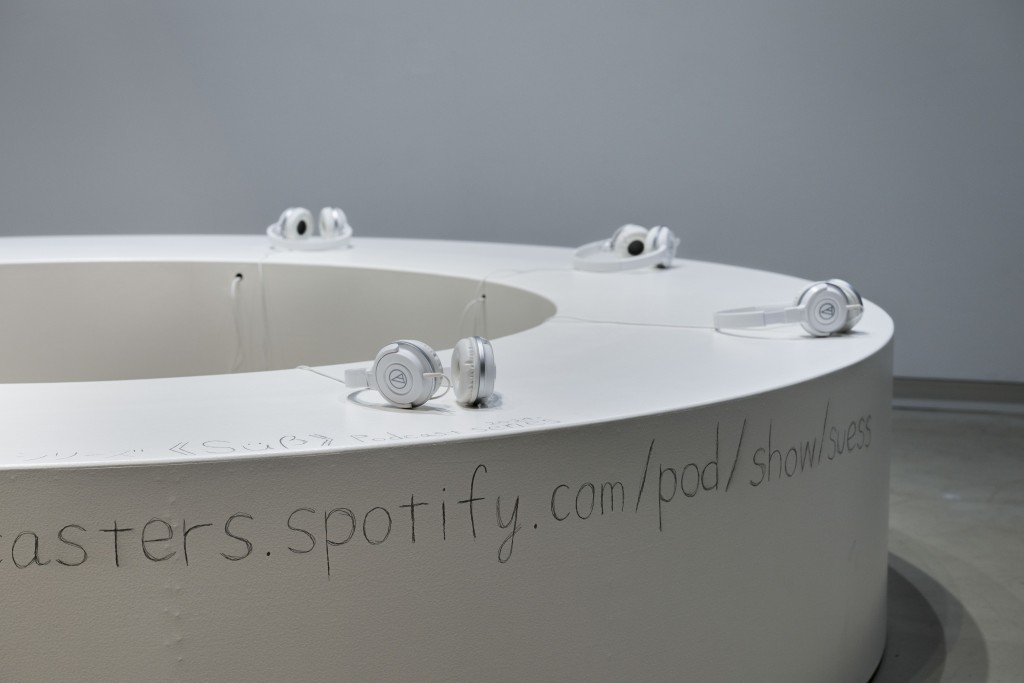Something like a Review of hayate kobyashi’s Exhibition Polyparole

Upon entering the exhibition room, what comes into view is the image of a man speaking into an apparatus that lights up in response to his words. In the short video work, To all the 1,344,900 mouth, Hayate Kobayashi creates and recites a poem directed toward all 1,344,900 zaigai-hōjin [在外邦人], or Japanese nationals who live overseas.
Zaigai-hōjin was a term that never even crossed my mind when I lived in Japan, but the moment that Japanese nationals start living abroad, they are referred to as such. The Japanese character hō [邦] (literally meaning “state,” but typically used to mean “Japanese”) seems to only be used in opposition to yō [洋], (meaning Western) as seen in terms like hōga [邦画] for Japanese film versus yōga [洋画] for Western film, and hōgaku [邦楽] for Japanese music in contrast to yōgaku [洋楽] for Western music. I mean, does yōga include Bollywood or Taiwanese movies? Does yōgaku include Middle Eastern, African, or Latin American music? Within this ambiguous system where only yō and hōsupposedly exist, those who are designated as zaigai-hōjin receive warning messages from the Ministry of Foreign Affairs and the embassy that reflect a yō, or Western, worldview(that is, if you are registered as a zaigai-hōjin). They say things like “Be cautious of riots after Ramadan,” or “Avoid visiting the Japanese embassy due to anti-whaling protests,” and so on. Around the same time that Kobayashi lived in Germany, I was also a zaigai-hōjin residing in a neighboring country. The announcement in December 2021 restricting the entry of Japanese nationals came as a tremendous shock to us zaigai-hōjin. Until then, Japan had actively allowed re-entry of Japanese nationals during the COVID-19 pandemic, even while restricting the entry of foreigners (which the WHO criticized as xenophobic from a human rights standpoint). However, during this time, zaigai-hōjin were also subjected to entry restrictions. Perhaps it was unavoidable given the circumstances, since even within Japan, people were discouraged from visiting their families to prevent the spread of the virus. Yet for zaigai-hojin, who are meant to be under Japan’s protection, it is likely that many felt a sense of abandonment.

The poem in the work seems to capture the uncertainty experienced during this period, a resistance to being labeled as zaigai-hōjin, and perhaps a sense of solidarity with the zaigai-hōjin living in various countries worldwide.“We eat something like a Chinakohl / We speak something like a Deutsch / We can’t obtain an origin / thus our contour of realities are / collapsing massively. / Let me shout for you / With our mother tongue. / The feeling of us, / for many.” In dailylog (2020-2022), Kobayashi speaks into a microphone in Japanese, expressing his inner thoughts about life in Berlin, almost as if he is talking to himself. In the work, he discusses how he often uses the phrase “something like___” to interpret various experiences in his daily life. For example, “I’m eating something like a cucumber” or “Ah, this view is something like the Tama River,” when referring to the landscape in Berlin. There is, in fact, a vegetable called Chinakohl that resembles napa cabbage in Germany, though it is not quite the same as what you eat in Japan. Although there are those who speak German fluently, if it is not your mother tongue, watching the news or public service announcements can leave behind feelings of frustration from only being able to grasp the general idea. It can feel like you’re falling into a quagmire of translation. Despite living in Germany, it becomes apparent that one cannot completely become German. Instead, one remains an immigrant who is “something like” a German.
Although the poem includes the expression, “Let me shout for you,” Kobayashi does not raise his voice in the video. Instead, he continuously murmurs into a mask-like apparatus, as if to seal his words inside it so no one can hear. When I asked whether the device had a name, Kobayashi replied, “Now that you mentioned it, it doesn’t have a name.” He added, “I just pictured a magic lantern.”
So, the piece is something like a phantasmagoria. Every time the speaker talks, an image of their mouth is projected from the device, as if the words themselves are made of light. The continuous projection of the speaker’s lips reminded me of Samuel Beckett’s play Not I (1972). In this theater piece, a floating mouth on stage (other parts of the body are covered) blurts out an incoherent rant at rapid speed. While Not I features a woman’s mouth, Hayate Kobayashi is a man who speaks slowly as if to savor each word. What these works have in common is that they disregard the body’s presence within the space (or presume its absence), and that the utterances are not meant to be understood by those who are listening. Instead of a dialogue with established rules and a mutual understanding between the speaker (Kobayashi/the mouth) and the listener (the audience/the Auditor character in Beckett’s play), the dichotomy between the two is rendered meaningless by these acts of purposeless speech that are directed at no specific audience.

The same mask-like apparatus appears in Space-in-translation (2023) and Appeartus (2024), which is exhibited behind a blackout curtain. The latter work features Kobayashi speeding through the streets of Tokyo on a bicycle, speaking into the mask-like apparatus, which lights up and projects an image of his mouth onto the ground. He responds in English to a recording of a phone conversation with a Korean immigrant man. The reading of intricately woven poetry in To all the 1,344,900 mouth and the recitation of Virginia Woolf’s writings in Exophonifesto #1(2023) includes moments of pause that evoke deep contemplation. In dailylog, there is a certain ease in how he lets the words flow out of him. In contrast, Kobayashi speaks while riding a bicycle in Appeartus, hindering his ability to focus on his words. Perhaps this is why he seems to respond haphazardly, twisting the other person’s words (although they are having an important conversation about being an Asian immigrant). However, these words fail to reach the person on the other end, who is just a recording of a previous phone conversation, and the image of the mouth is projected in vain, only to disappear again. The continuous, hazy, and awkward stringing together of images while moving from place to place bears a resemblance to The Reluming Apparatus, for which Kobayashi won the Japan Media Arts Festival’s New Face Award (Art Division) in 2020. In Appeartus, however, the fact that the medium is Kobayashi’s voice coming from his own body emphasizes the commentary that words fail to reach others as a coherent image.

Space-in-translation is a work based on conversations with the poet Liao Yiwu from Sichuan Province, China, who tried to flee to Berlin fourteen times before finally making it on his fifteenth attempt. Their dialogue explored the relationship between fiction and non-fiction in Wuhan: A Documentary Novel (2021) written by Yiwu during the COVID-19 pandemic. The discussions, which were mediated by a Chinese interpreter, were transcribed using video-editing software, translated into English using machine translation, and reconfigured into poetry. The text was then discussed with a friend from Yunnan Province, China, and elevated into a poem that captures the pain of Asian immigrants. Ultimately, the video work features Kobayashi and the friend from Yunnan reciting the poetry into the mask-like apparatus. Although subtitles in English, Chinese, and Japanese appear on the right, left, and bottom of the screen, they do not align in meaning, making it difficult to determine which subtitles to follow to understand the story. Fueled by the limitations of machine translation, awkward translation, and the voice that reaches the viewer without translation, new expressions emerge and flood the viewer in their attempt to capture meaning beyond translation. The work directly conveys the sharp pain of language felt by immigrants, zaigai-hōjin, and those who do not write in their mother tongue (i.e., exophony) in their relationship with words. As is expressed in To all the 1,344,900 mouth, “We can’t obtain an origin / thus our contour of realities are / collapsing massively.”

Kobayashi created the title of this exhibition, Polyparole, by combining the prefix “poly,” signifying plurality, and “parole,” which refers to individual acts of speech within a certain context. In the exhibition space, Kobayashi’s voice can be heard from multiple monitors that surround the viewers. Although Kobayashi must have interacted with people from various backgrounds while in Berlin, the only person who appears in the work is the shy artist himself, perhaps because the works were made during the pandemic. In dailylog and Tracing You (2022), the parole does not consist of words intended to evaluate the relationship between the self and the other, or construct a portrait of the self. Instead, it fluidly evades the role of “speaker,” seeming like an attempt to become “something like” another entity.
In one of his latest works, the podcast Süß (2024)*, Kobayashi finally appears on screen in conversation with others and appears to enjoy himself. The parole in this work has an intimate quality that is reminiscent of listening to the radio while quenching your thirst with something sweet, like the frappe drink served at the BUG Cafe topped with a cookie shaped like the Japanese letter “po [ポ] ” for “polyparole [ポリパロール].” At that moment, I realized that I had only been using my ears and eyes since entering the exhibition room. I want to sip on the “Poly-pa-rappe” drink to reconnect with myself as another “mouth” and remind myself of when I was once a part of the 1,344,900.
*meaning “sweet” in German



